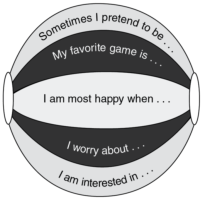|
Beach Ball Conversation
This is an excerpt from Healthy Breaks: Wellness Activities for the Classroom by Jenine M. De Marzo.
|

This activity is aimed at improving communication skills for all participants by providing the opportunity to share thoughts, feelings, and experiences using a low-key and informal approach.
- Students will be able to share thoughts, feelings, and experiences with their classmates.
- Students will be able to demonstrate that communicating with one another can enhance their personal health.
- Students will be able to recognize that we all experience life around us differently.
Grade Levels K-6
NHES Standards 1, 2, 4, 7
NASPE Standards 1, 2, 5, 6
Suggested Time Requirements 5-10 minutes
Large beach ball or large balloon; one marker
- This activity allows students to play where they are, either from their chairs or the floor. There is no reason to move desks, chairs, or equipment as long as students can throw and catch a beach ball or large balloon where they are seated or stationed.
- You can inflate the beach ball or balloon beforehand; deciding which to use depends on the ability of your least-skilled participant. A large beach ball that is not fully inflated is easily handled and slow-moving. A large inflated balloon is slower still, but for obvious reasons is less forgiving. Assess your group and choose a ball or balloon accordingly.
- Most beach balls are separated by sections, often differentiated by color; taking advantage of this design, you can write simple talking points on each section. If using the balloon, you can write these talking points in circles or section the balloon similar to the vertical sections on a hot air balloon.
- The talking points can be about anything; here are some examples:
I am most happy when . . .; What I like most about my life is . . .; I am interested in . . .;In my spare time I like to . . .; My favorite game is . . .; I am good at . . .; What I want most of all is . . .; I am . . .; I believe . . .; I am different because . . .; I worry about . . .; I wonder. . .; I hear . . .; I want . . .; I pretend . . .; I understand . . .; I dream . . .;I say . . .; I try . . .; I cry . . .
- For the kindergarten through 1st-grade crowd, you may want to use drawings of faces depicting happiness, sadness, surprise, anger, worry, laughter, crying, and so on. This will alleviate anxiety regarding reading ability with younger participants.
- From where they are in the room, students toss, hit, or pass the ball or balloon around the room.
- When someone catches it, he or she looks at the closest panel and reacts to the question or prompt. This answer can be simple or you may ask them to expand on the answer depending on the time allotted for the activity.
- If the same person gets the ball or balloon twice, he or she passes it to the nearest person so that he or she gets a turn.
- If students need to warm up to the exercise, allow them the option to “pass” once. However, the next time they receive the ball they must participate.
This is a slow-moving activity that can be done seated in chairs or in a circle; however, remind students that they should not lunge or grab at the ball or balloon because everyone will get a chance. Have a second balloon prepared in the event of a breakage.
You can make this more interesting by using music and playing it like hot potato. You may also want to encourage students to ask other students questions in an effort to get to know them better. For example, if a student catches the ball, he or she answers the question on the ball or balloon; you may then allow another student to ask a secondary question to prompt more communication.


|
|